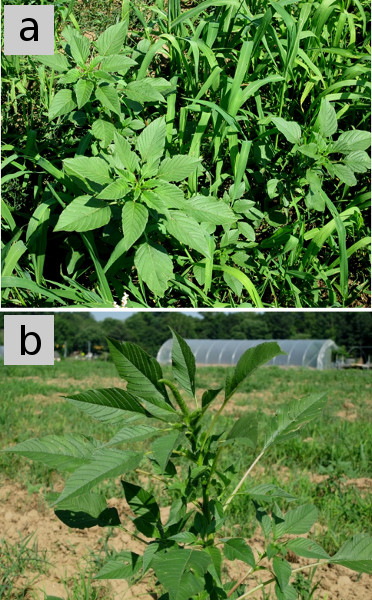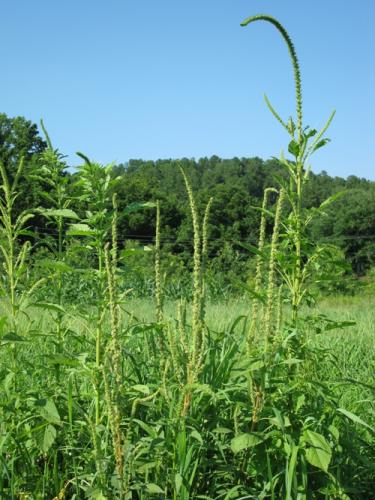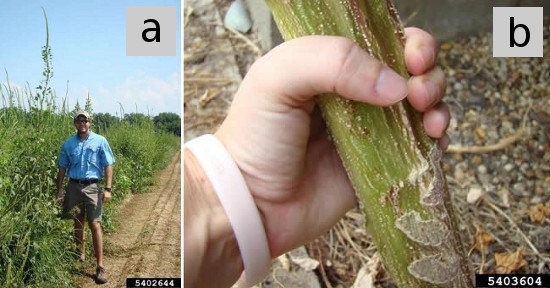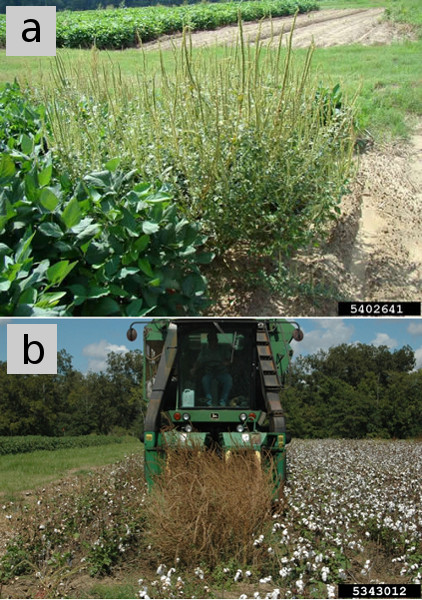eOrganic author:
Dr. Mark Schonbeck, Virginia Association for Biological Farming
Introduction
Palmer amaranth, also known as Palmer pigweed, is an extremely aggressive, fast-growing species that has become a serious weed problem in vegetable and row crops in the southern half of the United States in recent years. Native to the Sonoran Desert and the lower Rio Grande Valley (Ehleringer, 1983; Keely, 1987), Palmer amaranth readily invades croplands in hot climates. It became a major agricultural weed in the southern Great Plains by the late 1990s (Horak, 1997), and now infests at least 750,000 acres of cotton and other row crops in Arkansas, (Fugate, 2009) and over one million acres in Georgia (Langcuster, 2008). In addition, it has been cited as a major troublesome weed in vegetable production in North and South Carolina (Webster, 2006). Over the past 10 years, numerous reports have been published on Palmer amaranth documenting severe crop losses, and resistance to glyphosate and other herbicides (Culpepper et al., 2006; Horak and Peterson, 1995; Jha et al., 2008a, b).
Palmer amaranth is a tall, erect, branching summer annual, commonly reaching heights of 6–8 feet, and occasionally 10 feet or more. Stems and foliage are mostly smooth and lacking hairs (glabrous). Leaves have fairly long petioles and are arranged symmetrically around the stem, giving the plant a distinctly pointsettia-like appearance when viewed from above (Fig. 1). Leaf blades are elliptical to diamond-shaped with pointed tips, and measure 0.6–3 inches long by 0.4–1.5 inches wide.

Figure 1. (a) Palmer amaranth in vegetative growth stage, showing pointsettia-like growth habit. (b) Palmer amaranth at early head emergence, showing smooth, hairless foliage and stems. Photo credits: Mark Schonbeck, Virginia Association for Biological Farming.
Male and female flowers are borne on separate plants (dioecious), and the small (<0.25 inch) flowers are clustered tightly in linear or sparingly branched terminal spikes up to 18 inches long (Fig. 2). The perianth (whorl of petal-like structures) around each female flower bears small, rigid spines that give the female spikes a markedly bristly texture. In contrast, male inflorescences are fairly soft to the touch.

Figure 2. Palmer amaranth in bloom, including male plants with anthers shedding pollen (center) and a female plant (upper right). Photo credit: Mark Schonbeck, Virginia Association for Biological Farming.
Biology
In its native desert habitat, Palmer amaranth grows as a summer ephemeral herb supremely adapted to the rigors of intense heat and low, unpredictable rainfall (Ehleringer, 1983). Adaptive traits include the C4 photosynthetic pathway, a phenomenally high photosynthetic rate (even higher than most other C4 plants), optimum photosynthesis at leaf temperatures of 95–115 °F, capacity to continue photosynthesis under all but the most extreme drought stress, very high water use efficiency, and diurnal leaf movements that keep leaf blades perpendicular to the sun for maximum carbon fixation (Ibid.) . Additional traits include rapid seed germination, early seedling growth, and larger root volume than other amaranths (Steckel et al., 2004; Guo and Al-Khatib, 2003). Together, these traits allow Palmer amaranth to emerge, grow, and complete its life cycle on the soil moisture available at the time of germination (Ehleringer, 1983). In southern Arizona natural stands can attain dry weights of 2.2 tons per acre within 4 weeks after emergence (Ehleringer, 1983), which approaches the biomass of a mature winter annual cover crop.
In germination tests, Palmer amaranth seeds germinated rapidly—ithin 1–2 days—at a wide range of constant or alternating temperatures from 59–105 °F, with highest germination percentages and most rapid germination at 86–95 °F (Steckel et al, 2004; Guo and Al-Khatib, 2003). The primary requirement for germination seems to be moisture, as might be expected for a desert ephemeral. In the field, Palmer amaranth emergence occurs over an extended period (Jha et al., 2008b).
The seeds of Palmer amaranth have been reported to lose viability within 3 years when buried in the soil in Alabama and Georgia (Langcuster, 2008); however seed longevity in soil for the closely related redroot pigweed (A. retroflexus) and waterhemp (A. rudis) has been reported as short as 3–4 years in Mississippi and Illinois (Egley and Williams, 1990; Steckel et al., 2007) and as long as 12 years in Nebraska (Burnside et al., 1996). Thus, it is possible that some Palmer amaranth seeds remain viable in the soil for much longer than 3 years under certain conditions.
In field studies conducted in California (Keeley et al., 1987), Texas (Menges, 1988), Missouri (Sellers et al., 2003), Kansas (Horak, 1997; Horak and Loughin, 2000), and Arkansas (Fugate, 2009), Palmer amaranth has demonstrated a potential for extremely rapid growth and prolific seed set in cropland. It attained heights of 4 inches within 2–3 weeks after planting (WAP), and 35–40 inches at 5–7 WAP. For comparison, redroot pigweed and common waterhemp reached 2–3 inches at 2–3 WAP, and 20–30 inches at 5–7 WAP. Mature Palmer amaranth plants can reach heights of 6–10 ft with stems 2–3 inches thick (Fig. 3), forming 200–900 thousand mature seeds per female plant. Dry weight biomass of solid stands has been estimated as high as 5–9 tons per acre. Palmer amaranth considerably exceeded common waterhemp (Amaranthus rudis), redroot pigweed (A. retroflexus), and other Amaranthus species in height, dry weight, and leaf area in comparative growth analyses conducted under field conditions in Kansas (Horak and Loughin, 2000) and Missouri (Sellers et al, 2003). In growth chamber studies, Palmer amaranth grew more rapidly and formed larger root systems than redroot pigweed and common waterhemp in hot conditions (95 °F day, 86 °F night), and demonstrated the greatest heat tolerance and the least tolerance to cool conditions (Guo and Al-Khatib, 2003).

Figure 3. (a) Large specimen of Palmer amaranth, about 10 feet tall. (b) Stem of a mature Palmer amaranth. Photo credits: Rebekah D. Wallace, Bugwood.org.
Impact on Crops
The combination of rapid growth rate, adaptation to heat and drought, and large root volume makes Palmer amaranth an aggressive competitor against warm season crops (Fig. 4a), and a serious nuisance at harvest time (Fig. 4b). Once established, it can be very hard to control. In Georgia, some cotton farmers have resorted to manual pulling, as the weed has developed herbicide resistance, and regrows readily after chopping (Langcuster, 2008).

Figure 4. (a) A vigorous, much-branched Palmer amaranth has displaced the soybean crop from several feet of row. (b) Palmer amaranth in cotton at crop maturity interferes with harvest. Photo credit: (a) Rebekah D. Wallace, Bugwood.org; (b) Joseph LaForest, University of Georgia, Bugwood.org.
Palmer amaranth causes significant yield reductions in all agronomic row crops, especially when it emerges before or with the crop. In a field study in Arkansas, one Palmer amaranth per 10 ft of row reduced soybean grain yield by 17%, and one weed per foot of row cut yields 64% when crop and weeds emerged together (Klingman and Oliver, 1994). The amaranth exceeded the crop in height by 8–24 inches from 4 weeks after emergence through harvest. Corn yields were reduced 20% by one Palmer amaranth per 6.6 feet of row, and 40–80% by one weed per foot of row in Kansas (Massinga et al., 2001). Amaranth height exceeded that of corn, and its foliage intercepted light at a greater height above the ground than corn foliage (Massinga et al, 2003). However, when the weed emerged several weeks after corn, it had much less impact on yield, and its seed production was reduced by 80–98% (Massinga et al., 2001). In another Kansas field trial, Palmer amaranth planted with soybean reduced crop yield 28%, whereas Palmer amaranth planted 15–20 days after soybean had no effect on crop yield (Bensch et al., 1997).
Residues of Palmer amaranth can suppress crop growth. Greenhouse and field studies indicate that incorporation of a heavy stand of Palmer amaranth into the soil just before planting can significantly hinder seedling growth in carrot, onion, cabbage, and grain sorghum (Menges 1987, 1988), and the authors suggested that allelopathy (release of natural plant growth inhibitors from the residues) may play a role in this effect. The growth of Palmer amaranth itself may be retarded somewhat by allelochemicals from cover crops in the Brassica (mustard) family. Isothiocyanate compounds derived from Brassica residues reduced Palmer amaranth emergence in greenhouse trials (Norsworthy and Meehan, 2005). Incorporation of the cover crops themselves into field soil prior to planting pepper reduced Palmer amaranth levels by 25–50% during the first four weeks in one year out of two (Norsworthy et al., 2007).
Management Implications for Organic Production
Palmer amaranth is clearly the most aggressive pigweed in hot, humid to semiarid conditions. Organic producers in the southern half of the U.S. are well advised to get a positive identification on pigweeds to determine whether this species is present.
Like other pigweeds, Palmer amaranth is quite vulnerable to cultivation during the seedling stage, but its unusually rapid early development leaves a shorter time window for control. Diligent monitoring and timely intervention are critical for the control of Palmer amaranth, as cultivation and flaming are most effective on weeds not more than 1 inch tall.
The temperature optimum for Palmer amaranth growth is higher than that of most vegetable and row crops. Similarly, its drought tolerance is greater than that of most cultivated crops. In cooler conditions with adequate moisture, the weed may lose its competitive edge against most crops. Therefore, planting dates may be a significant factor in managing Palmer amaranth; for example, frost-tender vegetables like tomato or snap bean may be grown in spring or fall in the Gulf Coast states, when moderate temperatures favor the vegetable over the weed.
Although Palmer amaranth seeds may have limited longevity in the soil in hot, rainy climates (Langcuster, 2008), it is especially important to prevent seed production by this weed in order to draw down the seed bank. In intensive vegetable production, it is worth the effort to pull out any Palmer amaranth individuals that escape cultivation before they set seed. If a heavy seed shed of Palmer amaranth occurs, inversion tillage may be useful in limiting weed emergence in the following season; however, additional inversion should be avoided for the next several years so that viable Palmer amaranth seeds are not brought back to the surface.
A diversified crop rotation that varies tillage, planting, and harvest schedules from year to year as well as crop species and plant family, can help reduce problems with summer annual weeds, and may be helpful in managing Palmer amaranth. Incorporating a radish, mustard, or other brassica green manure may help slow emergence and growth of Palmer amaranth; however brassica allelopathy should not be counted on to control the weed. Caution must also be taken to avoid suppressing crop germination, emergence, and growth by brassica residues, especially in direct-sown small-seeded vegetables and peas.
The organic weed management techniques outlined in the general article on pigweeds are appropriate. Additional recommendations for fields with significant populations of Palmer amaranth include:
- After planting, scout every 2–3 days for weed emergence.
- When pigweed seedlings are detected, cultivate or flame immediately – don't wait until you can determine whether they are Palmer amaranth.
- If practical, adjust planting dates to avoid weed–crop competition during very hot weather.
- To reduce heavy infestations, rotate to cool season production crops, and focus on weed control through timely tillage and cover cropping during summer months.
References Cited
- Bensch, C. J., M. J. Horak, and D. E. Peterson. 1997. Competition of three Amaranthus species in soybean. North Central Weed Science Society Proceedings 52: 148.
- Burnside, O. C., R. G. Wilson, S. Weisberg, and K. G. Hubbard. 1996. Seed longevity of 41 weed species buried 17 years in eastern and western Nebraska. Weed Science 44: 74–86. (Available online at: http://www.jstor.org/stable/4045786) (verified 10 Sept 2012).
- Culpeper, A. S., T. L. Grey, W. K. Vencill, J. M. Kitchler, T. M. Webster, S. M. Brown, A. C. York, J. W. Davis, and W. W. Hanna. 2006. Glyphosate-resistant Palmer amaranth (Amaranthus palmeri) confirmed in Georgia. Weed Science 54: 620–626. (Available online at: http://dx.doi.org/10.1614/WS-06-001R.1) (verified 10 Sept 2012).
- Egley, G. H., and R. D. Williams. 1990. Decline of weed seeds and seedling emergence over five years as affected by soil disturbances. Weed Science 38: 504–510. (Available online at: http://www.jstor.org/stable/4045064) (verified 10 Sept 2012).
- Ehleringer, J. 1983. Ecophysiology of Amaranthus palmeri, a Sonoran desert summer annual. Oecologia 57: 107–112. (Available online at: http://dx.doi.org/10.1007/BF00379568) (verified 10 Sept 2012).
- Fugate, L. 2009. Pigweed causing farmers to rethink farming methods. University of Arkansas Division of Agriculture Cooperative Extension Service News - October 2009.
- Guo, P., and K. Al-Khatib. 2003. Temperature effects on germination and growth of redroot pigweed (Amaranthus retroflexus), Palmer amaranth (A. palmeri), and common waterhemp (A. rudis). Weed Science 51: 869–875. (Available online at: http://dx.doi.org/10.1614/P2002-127) (verified 10 Sept 2012).
- Horak, M. J. 1997. The changing nature of palmer amaranth: A case study. North Central Weed Science Society Proceedings 52: 161.
- Horak, M. J., and T. M. Loughin. 2000. Growth analysis of four Amaranthus species. Weed Science 48: 347–355. (Available online at: http://dx.doi.org/10.1614/0043-1745(2000)048%5B0347:GAOFAS%5D2.0.CO;2) (verified 10 Sept 2012).
- Horak, M. J., and D. E. Peterson. 1995. Biotypes of Palmer amaranth (Amaranthus palmeri) and common waterhemp (Amaranthus rudis) are resistant to imazethapyr and thifensulfuron. Weed Technology 9: 192–195. (Available online at: http://www.jstor.org/stable/3987844) (verified 10 Sept 2012).
- Jha, P., J. K. Norsworthy, W. Bridges, Jr., and M. B. Riley. 2008a. Influence of glyphosate timing and row width on Palmer amaranth (Amaranthus palmeri) and pusley (Richardia spp.) demographies in glyphosate-resistant soybean. Weed Science 56: 408–415. (Available online at: http://dx.doi.org/10.1614/WS-07-174.1) (verified 10 Sept 2012).
- Jha, P., J. K. Norsworthy, M. B. Riley, D. G. Bielenberg, and W. Bridges, Jr. 2008b. Acclimation of Palmer amaranth (Amaranthus palmeri) to shading. Weed Science 56: 729–734. (Available online at: http://dx.doi.org/10.1614/WS-07-203.1) (verified 10 Sept 2012).
- Keeley, P. E., C. H. Carter, and R. J. Thullen. 1987. Influence of planting date on growth of Palmer amaranth (Amaranthus palmeri). Weed Science 35: 199–204. (Available online at: http://www.jstor.org/stable/4044391) (verified 10 Sept 2012).
- Klingman, T. E., and L. R. Oliver. 1994. Palmer amaranth (Amaranthus palmeri) interference in soybeans (Glycine max). Weed Science 42: 523–527. (Available online at: http://www.jstor.org/stable/4045448) (verified 10 Sept 2012).
- Langcuster, J. 2008. Scarier than Halloween – the nightmare weed that threatens Southern row crops. Extension Daily, Alabama Cooperative Extension, October 22, 2008. (Available online at: http://www.agfax.com/news/2008/10/alnightmareweed1023.htm) (verified 10 Sept 2012).
- Massinga, R. A., R. S. Currie, M. J. Horak, and J. Boyer, Jr. 2001. Interference of Palmer amaranth in corn. Weed Science 49: 202–208. (Available online at: http://dx.doi.org/10.1614/0043-1745(2001)049%5B0202:IOPAIC%5D2.0.CO;2) (verified 10 Sept 2012).
- Massinga, R. A., R. S. Currie, and T. P. Trooien. 2003. Water use and light interception under Palmer amaranth (Amaranthus palmeri) and corn competition. Weed Science 51: 523–531. (Available online at: http://dx.doi.org/10.1614/0043-1745(2003)051%5B0523:WUALIU%5D2.0.CO;2) (verified 10 Sept 2012).
- Menges, R. M. 1987. Allelopathic effects of Palmer amaranth (Amaranthus palmeri) and other plant residues in soil. Weed Science 35: 339–347. (Available online at: http://www.jstor.org/stable/4044595) (verified 10 Sept 2012).
- Menges, R. M. 1988. Allelopathic effects of Palmer amaranth (Amaranthus palmeri) on seedling growth. Weed Science 36: 325–328. (Available online at: http://www.jstor.org/stable/4044643) (verified 10 Sept 2012).
- Norsworthy, J. K., M. S. Malik, P. Jha, and M. B. Riley. 2007. Suppression of Digitaria sanguinalis and Amaranthus palmeri using autumn-sown glucosinolate-producing cover crops in organically grown pepper. Weed Research 47: 425–432. (Available online at: http://dx.doi.org/10.1111/j.1365-3180.2007.00586.x) (verified 10 Sept 2012).
- Norsworthy, J. K., and J. T. Meehan, IV. 2005. Use of isothiocyanates for suppression of Palmer amaranth (Amaranthus palmeri), pitted morningglory (Ipomoea lacunose), and yellow nutsedge (Cyperus esculentus). Weed Science 53: 884–890. (Available online at: http://dx.doi.org/10.1614/WS-05-056R.1) (verified 10 Sept 2012).
- Sellers, B. A., R. J. Smeda, W. G. Johnson, J. A. Kendig, and M. R. Ellersieck. 2003. Comparative growth of six Amaranthus species in Missouri. Weed Science 51: 329–333. (Available online at: http://dx.doi.org/10.1614/0043-1745(2003)051%5B0329:CGOSAS%5D2.0.CO;2) (verified 10 Sept 2012).
- Steckel, L. E., C. L. Sprague, E. W. Stoller, and L. M. Wax. 2004. Temperature effects on germination of nine Amaranthus species. Weed Science 52: 217–221. (Available online at: http://dx.doi.org/10.1614/WS-03-012R) (verified 10 Sept 2012).
- Steckel, L. E., C. L. Sprague, E. W. Stoller, L. M. Wax, and F. W. Simmons. 2007. Tillage, cropping system, and soil depth effects on common waterhemp (Amaranthus rudis) seed-bank persistence. Weed Science 55: 235–239. (Available online at: http://dx.doi.org/10.1614/WS-06-198) (verified 10 Sept 2012).
- Webster, T. M. 2006. Weed survey – southern states. Vegetable, fruit and nut crops subsection. Proceedings of the Southern Weed Science Society 59: 260–277. (Available online at: http://www.swss.ws/wp-content/uploads/docs/2006%20Proceedings-SWSS.pdf) (verified 10 Sept 2012).



